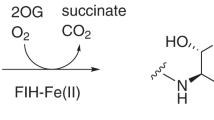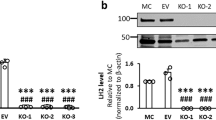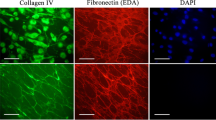Abstract
The biosynthesis of trans-3- and trans-4-hydroxyprolines and 5-hydroxylysine in animal cells requires polypeptide proline or lysine, enzymes and cofactors including iron, and possibly involves peroxidatic intermediates1. Several laboratories have reported the presence of low-molecular-weight hydroxyproline and hydroxylysine peptides in cell and organ cultures2–5. We found that these small peptides contained the trans-3 and cis-4 isomers of hydroxyproline as well as trans-4 ones and that their production was not completely inhibited by α, α-dipyridyl, an iron chelator and effective inhibitor of enzyme-mediated hydroxylations5. It is known that oxygen or hydrogen peroxide in the presence of metal can hydroxylate proline and other aromatic compounds6–11. We show here that reduced oxygen derivatives can hydroxylate both free and poly peptide-bound proline and lysine, and that scavengers of hydroxyl radicals suppress, but do not completely inhibit, this reaction. Reduced oxygen derivatives can be generated in normal and pathological circumstances12, and some of the low-molecular-weight hydroxyproline and hydroxylysine peptides found in cell and organ cultures might be derived from these derivatives and therefore do not reflect collagen turnover, but rather some other cellular activity.
This is a preview of subscription content, access via your institution
Access options
Subscribe to this journal
Receive 51 print issues and online access
$199.00 per year
only $3.90 per issue
Buy this article
- Purchase on Springer Link
- Instant access to full article PDF
Prices may be subject to local taxes which are calculated during checkout
Similar content being viewed by others
References
Myllyla, R., Schubotz, L. M., Weser, U. & Kivirikko, K. Biochem. biophys. Res. Commun. 89, 98–102 (1979).
Steinberg, J. J. Cell Sci. 12, 217–234 (1973).
Nourse, P. N., Nourse, L. D. & Botes, H. S. Afr. J. Sci. 70, 231–234 (1974).
Bienkowski, R. S., Cowan, M. J., McDonald, J. A. & Crystal, R. G. J. biol Chem. 253, 4356–4363 (1978).
Holmes, L. B. & Trelstad, R. L. Devl Biol. 72, 41–49 (1979).
Chvapil, M. & Hurych, J. Nature 184, 1145 (1959).
Lamport, D. T. A. Nature 202, 293–294 (1964).
Yip, C. C. Biochim. biophys. Acta 92, 395–396 (1964).
Gruber, H. A. & Mellon, E. F. Analyt. Biochem. 66, 78–86 (1975).
Udenfriend, S., Clark, C. T., Axelrod, J. & Brodie, B. B. J. biol. Chem. 208, 731–739 (1954).
Breslow, R. & Lukens, L. N. J. biol. Chem. 235, 292–296 (1960).
Hayaishi, O. & Asada, K. (eds) Biochemical and Medical Aspects of Active Oxygen (University Park Press, Baltimore, 1977).
Cintron, C., Peczon, B. D. & Kublin, C. L. Analyt. Biochem. 87, 622–630 (1978).
Villanueva, V. R. & Lederer, E. FEES Lett. 52, 308–311 (1975).
Kivirikko, K. I. Int. Rev. Connective Tissue Res. 5, 93–163 (1970).
Dziewiatkowski, D. D., Hascall, V. C. & Riolo, R. L. Analyt. Biochem. 49, 550–558 (1972).
Mauger, A. B. & Witkop, B. Chem. Rev. 66, 47–86 (1966).
Irreverre, F. & Witkop, B. J. Chromat. 43, 127–128 (1969).
Michelson, A. M., McCord, J. M. & Fridovich, I. (eds) Superoxide and Superoxide Dismutases (Academic, London, 1977).
Foerder, C. A. & Shapiro, B. M. Proc. natn. Acad. Sci. U.S.A. 74, 4214–4218 (1977).
DeVore, D. P. & Gruebel, R. J. Biochem. biophys. Res. Commun. 80, 993–999 (1978).
Waykole, P. & Heidemann, E. Connective Tissue Res. 4, 219–222 (1976).
LaBella, F., Keeley, F., Vivian, S. & Thornhill, D. Biochem. biophys. Res. Commun. 26, 748–753 (1967).
Andersen, S. D. Biochim. biophys. Acta. 93, 213–215 (1964).
McCord, J. M. Science 185, 529–531 (1974).
Petrone, W. F., English, D. K., Wong, K. & McCord, J. M. Proc. natn. Acad. Sci. U.S.A. 77, 1159–1163 (1980).
Postlethwaite, A. E., Seyer, J. M. & Kang, A.H. Proc. natn. Acad. Sci. U.S.A. 75, 871–875 (1978).
Rosenbloom, J. & Prockop, D. J. J. biol. Chem. 245, 3361–3368 (1970).
Fridovitch, I. Science 201, 875–880 (1978).
Author information
Authors and Affiliations
Rights and permissions
About this article
Cite this article
Trelstad, R., Lawley, K. & Holmes, L. Nonenzymatic hydroxylations of proline and lysine by reduced oxygen derivatives. Nature 289, 310–312 (1981). https://doi.org/10.1038/289310a0
Received:
Accepted:
Issue Date:
DOI: https://doi.org/10.1038/289310a0
This article is cited by
-
TcrXY is an acid-sensing two-component transcriptional regulator of Mycobacterium tuberculosis required for persistent infection
Nature Communications (2024)
-
UV oxidation of cyclic AMP receptor protein, a global bacterial gene regulator, decreases DNA binding and cleaves DNA at specific sites
Scientific Reports (2020)
-
Biochemical and histopathologic effects of omeprazole and vitamin E in rats with corrosive esophageal burns
Pediatric Surgery International (2008)
Comments
By submitting a comment you agree to abide by our Terms and Community Guidelines. If you find something abusive or that does not comply with our terms or guidelines please flag it as inappropriate.



